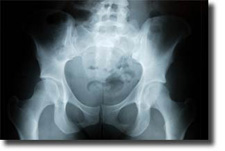Frozen Pelvis

Facts About Endometriosis and a Frozen Pelvis
The term frozen pelvis may sound unusual, but it is commonly found in women who have been diagnosed with endometriosis. This is a serious problem that often causes tremendous pain and can lead to irreparable damage to the uterus and infertility.
Endometriosis occurs when tissue that is normally found only in the uterus begins to grow outside of uterus in other areas of the abdominal cavity. A frozen pelvis happens when this tissue begins to spread into the abdominal cavity, causing other organs of the pelvic region to become fused together.
Usually, the endometrial tissue is found only in the lining of the uterus, where it is shed once a month during a woman’s menstrual cycle. When endometriosis strikes, tissue that normally is found only in the uterine lining travels outside of the uterus, through the fallopian tubes, and enters the abdominal region. This tissue does not naturally belong in the pelvic area, so it irritates the tissue in the abdomen and causes it to scar. The scarred tissue is sticky, which is why the organs can then become fused together.
The fusing of internal organs caused by endometriosis and a frozen pelvis can appear in many different ways in the abdominal area, and every situation will be unique. The endometrial tissue can attach to any part of the pelvis. That means the uterus can fuse with some part of the intestine, or perhaps the fallopian tubes and ovaries will become attached to the uterus. In some cases, an organ can fuse with a scar from a previous Cesarean section, or the abdominal wall may fuse together with a neighboring organ, like the bladder. Each situation will be unique, and the fusing can happen in a number of different ways.
Regardless of the manner in which the endometrial tissues and organs become fused together, the symptoms of this serious illness are quite similar:
> Erratic menstrual cycle
> Extreme fatigue
> Heavier than normal menstrual bleeding
> Severe abdominal pain
Because of the fusing that occurs between organs when a woman has endometriosis, there can be multiple difficulties that stem from this one illness. Depending on what organs become attached, endometriosis can lead to bowel obstruction, urinary tract infections and other medical concerns. In some cases, surgery may be required to correct organ fusing that stems from this serious illness.
Another major crisis that can be caused by endometriosis is infertility. If any of the fusing affects the reproductive organs, this may interfere with reproduction and can be the main cause of infertility. The excess endometrial tissue can have an impact on the fallopian tubes or ovaries, blocking the eggs or causing the organs to become distorted and unable to perform their reproductive function properly. Your doctor can determine if endometriosis is the cause of infertility by performing a laparoscopy, which is a minor surgical procedure that allows the doctor to view the inside of the entire abdominal region to see if the organs are working normally.
There are a few different treatments for a frozen pelvis, including hormone therapy and physical therapy. Treatment for endometriosis tends to be more long-term, because the fusing stage means that the illness has been affecting the abdominal cavity for quite some time. Hormone therapy works to cause the endometrial tissue to shed away from the abdominal organs, much in the same way hormones cause menstruation. Physical therapy may be used to stretch out the affected areas in order to detach the parts that may be fused together. In severe cases, surgery may be the best treatment.